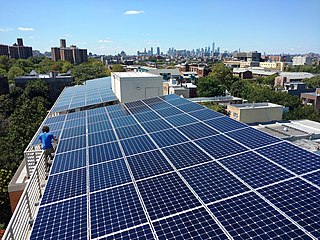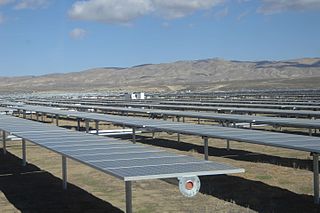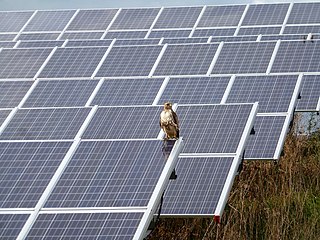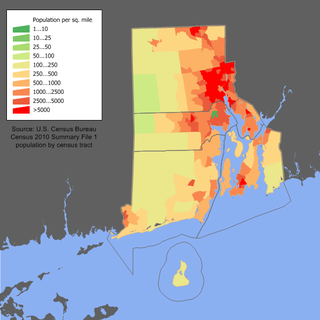Related Research Articles

Southern California Edison (SCE), the largest subsidiary of Edison International, is the primary electric utility company for much of Southern California. It provides 15 million people with electricity across a service territory of approximately 50,000 square miles.

Space-based solar power is the concept of collecting solar power in outer space with solar power satellites (SPS) and distributing it to Earth. Its advantages include a higher collection of energy due to the lack of reflection and absorption by the atmosphere, the possibility of very little night, and a better ability to orient to face the Sun. Space-based solar power systems convert sunlight to some other form of energy which can be transmitted through the atmosphere to receivers on the Earth's surface.

Solar power includes solar farms as well as local distributed generation, mostly on rooftops and increasingly from community solar arrays. In 2023, utility-scale solar power generated 164.5 terawatt-hours (TWh), or 3.9% of electricity in the United States. Total solar generation that year, including estimated small-scale photovoltaic generation, was 238 TWh.
The Carrizo Energy Solar Farm was a proposed 177 megawatt (MW) solar thermal power plant, to be built by Ausra in California's Carrizo Plain, near Simmler. The location gets less sun than the Mojave Desert, where several other solar thermal plants are under consideration, but is near an existing transmission line from Diablo Canyon Power Plant, reducing the cost and time needed to construct the plant.
BrightSource Energy, Inc. is an Oakland, California based, corporation that designs, builds, finances, and operates utility-scale solar power plants. Greentech Media ranked BrightSource as one of the top 10 greentech startups in the world in 2008.

Topaz Solar Farm is a 550 megawatt (MWAC) photovoltaic power station in San Luis Obispo County, California, United States. Construction on the project began in November 2011 and ended in November 2014. It is one of the world's largest solar farms. The $2.5 billion project includes 9 million CdTe photovoltaic modules based on thin-film technology, manufactured by U.S. company First Solar. The company also built, operates and maintains the project for MidAmerican Renewables, a Berkshire Hathaway company. Pacific Gas and Electric will buy the electricity under a 25-year power purchase agreement. According to First Solar, it created about 400 construction jobs.

The California Valley Solar Ranch (CVSR) is a 250 megawatt (MWAC) photovoltaic power plant in the Carrizo Plain, northeast of California Valley. The project is owned by NRG Energy, and SunPower is the EPC contractor and technology provider. The project constructed on 1,966 acres (796 ha) of a 4,365-acre (1,766 ha) site of former grazing land. It is utilizing high-efficiency, crystalline PV panels designed and manufactured by SunPower. The project includes up to 88,000 SunPower solar tracking devices to hold PV panels that track the sun across the sky.

The use of solar energy began in Israel in the 1950s with the development by Levi Yissar of a solar water heater to address the energy shortages that plagued the new country. By 1967 around 5% of water of households were solar heated and 50,000 solar heaters had been sold. With the 1970s oil crisis, Harry Zvi Tabor developed the prototype of the solar water heater now used in over 90% of Israeli homes. There are over 1.3 million solar water heaters installed as a result of mandatory solar water heating regulations.

Solar power has been growing rapidly in the U.S. state of California because of high insolation, community support, declining solar costs, and a renewable portfolio standard which requires that 60% of California's electricity come from renewable resources by 2030, with 100% by 2045. Much of this is expected to come from solar power via photovoltaic facilities or concentrated solar power facilities.

Energy in Afghanistan is provided by hydropower followed by fossil fuel and solar power. Currently, less than 50% of Afghanistan's population has access to electricity. This covers the major cities in the country. Many rural areas do not have access to adequate electricity but this should change after the major CASA-1000 project is completed.
The Mesquite Solar project is a 512.5-megawatt (MWAC) photovoltaic power plant in Arlington, Maricopa County, Arizona, owned by Sempra Generation and Consolidated Edison Development Inc. The first three phases of the project were constructed using more than 2.1 million crystalline silicon solar panels made by Suntech Power. Mesquite 4 and 5 added another 112.5 MW and 70 MW of battery storage.

A rooftop solar power system, or rooftop PV system, is a photovoltaic (PV) system that has its electricity-generating solar panels mounted on the rooftop of a residential or commercial building or structure. The various components of such a system include photovoltaic modules, mounting systems, cables, solar inverters battery storage systems, charge controllers, monitoring systems, racking and mounting systems, energy management systems, net metering systems, disconnect switches, grounding equipment, protective devices, combiner boxes, weatherproof enclosures and other electrical accessories.

Solar power in Mexico has the potential to produce vast amounts of energy. 70% of the country has an insolation of greater than 4.5 kWh/m2/day. Using 15% efficient photovoltaics, a square 25 km (16 mi) on each side in the state of Chihuahua or the Sonoran Desert could supply all of Mexico's electricity.

Solar power in Florida has been increasing, as the cost of solar power systems using photovoltaics (PV) has decreased in recent years. Florida has low electricity costs compared with other states, which makes individual solar investment less attractive. Florida ranks ninth nationally in solar resource strength according to the National Renewable Energy Laboratory and tenth in solar generation by the Solar Energy Industries Association.

Solar power in Michigan has been growing in recent years due to new technological improvements, falling solar prices and a variety of regulatory actions and financial incentives. The largest solar farm in Michigan is Assembly Solar, completed in 2022, which has 347 MW of capacity. Small-scale solar provided 50% of Michigan solar electricity as recently as 2020 but multiple solar farms in the 100 MW to 200 MW range are proposed to be completed by the middle of the decade. Although among the lowest U.S. states for solar irradiance, Michigan mostly lies farther south than Germany where solar power is heavily deployed. Michigan is expected to use 120 TWh per year in 2030. To reach a 100% solar electrical grid would require 2.4% of Michigan's land area to host 108 GW of installed capacity.

Solar power in Rhode Island has become economical due to new technological improvements and a variety of regulatory actions and financial incentives, particularly a 30% federal tax credit, available through 2016, for any size project. A typical residential installation could pay for itself in utility bill savings in 14 years, and generate a profit for the remainder of its 25 year life. Larger systems, from 10 kW to 5 MW, receive a feed-in tariff of up to 33.45¢/kWh.

Solar power in Oklahoma can provide 44.1% of all electricity used in Oklahoma from 19,300 MW of rooftop solar panels. This scenario is extremely unlikely though because the cost of electricity in Oklahoma is among the lowest in the nation.
Mount Signal Solar, also known as Imperial Valley Solar Project, is a 794 MWp (614 MWAC) photovoltaic power station west of Calexico, California, United States, in the southern Imperial Valley, near the Mexican border. The facility was developed and constructed by 8minutenergy Renewables in three phases, with two completed as of 2018, and the third in 2020. It is one of the world's largest PV solar farms with a capacity of about 800 MWp (600 MWAC). The project has been supported by several environmental groups, as the power station was built on low-productivity farmland.

California produces more renewable energy than any other state in the United States except Texas. In 2018, California ranked first in the nation as a producer of electricity from solar, geothermal, and biomass resources and fourth in the nation in conventional hydroelectric power generation. As of 2017, over half of the electricity (52.7%) produced was from renewable sources.
There are many practical applications for solar panels or photovoltaics. From the fields of the agricultural industry as a power source for irrigation to its usage in remote health care facilities to refrigerate medical supplies. Other applications include power generation at various scales and attempts to integrate them into homes and public infrastructure. PV modules are used in photovoltaic systems and include a large variety of electrical devices.
References
- ↑ "Next100 - A Dialogue on the Next Century of Energy". Archived from the original on 2009-04-15. Retrieved 2009-04-14.
- ↑ "California's new power source a solar farm". Sfgate.com. 14 April 2009. Retrieved 19 July 2018.
- ↑ "MSN - Outlook, Office, Skype, Bing, Breaking News, and Latest Videos". NBC News. Archived from the original on February 12, 2013. Retrieved 19 July 2018.
- ↑ "Calif. Considering Space Solar Power: Discovery News". Archived from the original on 2009-04-20. Retrieved 2009-04-21.
- ↑ "What If Giant Space-Based Solar Panels Could Beam Unlimited Power To The Earth?". Businessinsider.com. Retrieved 19 July 2018.
- ↑ "FACEBOOK POST REFERENCING SOLAREN SPACE SOLAR – SETTING THE RECORD STRAIGHT". solarenspace.com. Retrieved 28 September 2024.
- ↑ Solarens plan from outer space Archived 2009-04-17 at the Wayback Machine